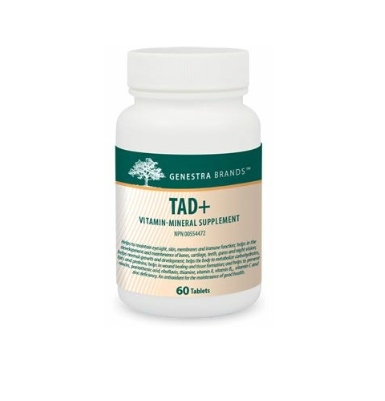Genestra
TAD+
TAD+
Couldn't load pickup availability
• Supports macronutrient metabolism and healthy skin
• Helps to maintain eyesight, skin, membranes and immune function
• Aids in the development and maintenance of bones, cartilage, teeth and gums
• Helps to prevent vitamin A, vitamin C and zinc deficiency
• Provides 9999 IU of vitamin A per daily dose
• Includes 498 mg of vitamin C and 24 mg of zinc per daily dose
TAD+ is a multivitamin combination that helps the body metabolize macronutrients and maintain skin health. B vitamins help mediate hundreds of enzymatic reactions, including the formation of substrates for energy production in the Krebs cycle.1
Zinc is highly present in the epidermis, and is needed for the proliferation of epidermal cells.2
Production of the retinol-binding protein, which transports vitamin A in cells, also depends on zinc.3
Vitamin A has three primary roles in the body: 1) help maintain the skin-s barrier function by increasing epidermal thickness and the number of glycosaminoglycans - polysaccharides that help hydrate the skin; 2) aid in the production of rhodopsin for sensing light, especially in low light environments; 3) stimulate the development of immune cells.4-6 Vitamin C contributes to the maintenance of bones, cartilage, teeth and gums through its role in the synthesis of collagen, the primary structural protein found in connective tissue.1
Vitamin C is also involved in wound healing, and helps to maintain good health by preventing free radical damage to DNA.1
NPN 80037033
08301120
1. Combs, GF. (2012). The Vitamins (4th ed.). USA: Elsevier.
2. Schwartz, JR, Marsh, RG, Draelos, ZD. Zinc and Skin Health: Overview of Physiology and Pharmacology. Dermatol Surg. 2005; 31: 837-847.
3. Meunier, N, O-Connor, JM, Maiani, G, Cashman, KD, Secker, DL, Ferry, M, Coudray, C. Importance of zinc in the elderly: the ZENITH study. European Journal of Clinical Nutrition. 2005; 59(Suppl 2): S1-S4.
4. Ruhl, R. Effects of dietary retinoids and carotenoids on immune development. Proceedings of the Nutrition Society. 2007; 66: 458-469.
5. Al Tanoury, Z, Piskunov, A, Rochette-Egly, C. Vitamin A and retinoid signaling: genomic and nongenomic effects. Journal of Lipid Research. 2013; 54: 1761-1775.
6. Mukherjee, S, Date, A, Patravale, V, Korting, HC, Roeder, A, Weindl, G. Retinoids in the treatment of skin aging: an overview of clinical efficacy and safety. Clinical Interventions in Aging. 2006; 1(4): 327-348.
As always, please consult with your doctor before starting any new treatments
Share


